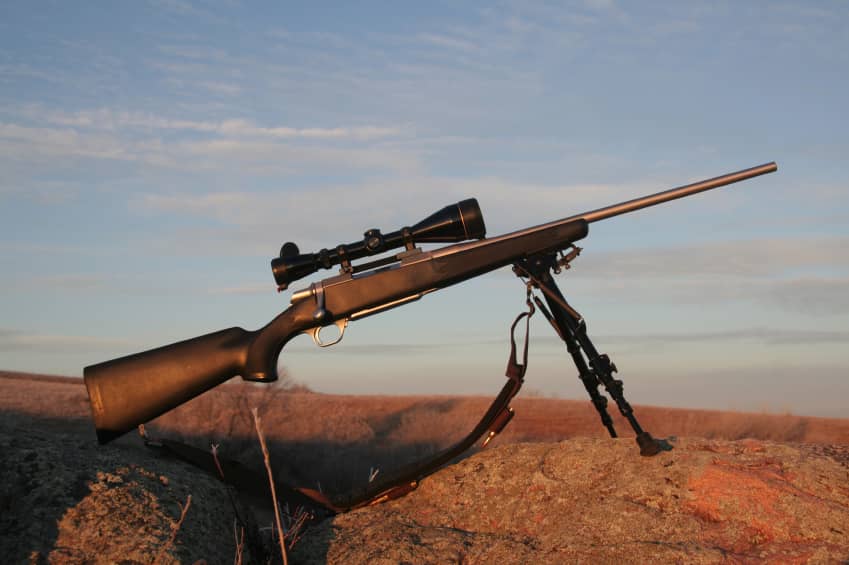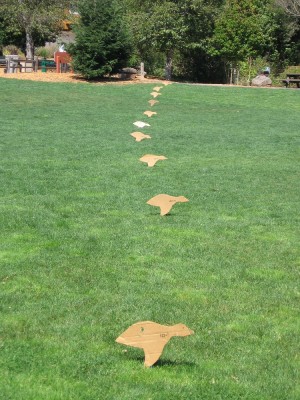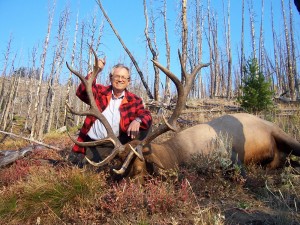Long Shots: When Does Hunting Become Target Shooting?
James Swan 03.11.13

Nice shot. How long was it? What was the target?
Bowhunter education teaches to work for shots 20 yards and less to ensure the greatest chance of killing big game with a broadhead. Sure, maybe you could hit the animal in the kill zone at longer distances, but with what consistency?

To study shotgun effectiveness, I made a series of 10 cardboard silhouettes of a mallard and placed them at 10-yard intervals out to 100 yards. At 10 yards, a 12 gauge with #7 shot just blows big holes in the silhouettes; this translates into non-edible birds. The following are the results of my test:
- At 20 yards: 151 pellets–lots of picking
- 30 yards: 46 pellets
- 40 yards: 10-15 pellets
- 50 yards: 16 pellets
- 60 yards: 10 pellets
- 70 yards: 13 pellets
- 80 yards: 5 pellets
- 90 yards: 6 pellets
At 80 or more yards with #7 shot, even if you do hit something, the penetrating power is spent and it will leave a bruise, at most (for some reason I almost never seem to hit the cardboard target at 100).
Shooting steel shot, you lose some of punch from lead shot, and end up wounding birds that would have been dead with lead shot. Personally, I use BB’s 2-shot for waterfowl, as 1-2 pellets of this size will kill birds that otherwise might just be wounded with 4-5 steel shot. Even though heavier shot has better lethality, I don’t lengthen the shooting zone because patterns get blown out beyond that distance.
I recommend learning to estimate 40 yards as a goal for waterfowl hunting. Practice it any time and any place until you get it down. When I set out duck decoys, I place a goldeneye decoy at 40 yards so its striking black and white colors will remind me of what my maximum shooting range should be.
Rifles and distance in hunting is a different matter. Personally, when I was growing up in Michigan hunting whitetails, no one had telescopic sights on their rifles, the shots were too close and in brush. We used iron sights on .30-30s and shotguns with slugs or buckshot. A 75-yard shot was long range. Western hunting for mule deer, antelope, mountain goat and sheep, and elk, however, may involve shooting over longer distances. But, as modern weaponry has developed, the possibility of taking game at extraordinarily long range has developed, resulting in practical and ethical issues.
Combine telescopic sights with modern technology and shells, and shots of 900 yards or more are now possible. Military snipers, using .338 Lapua Magnum ammo, have confirmed kills out to 2,700 yards in modern warfare. Using a .50 caliber Barrett rifle, sniper kills have been made over 3,000 yards.
That’s pretty incredible shooting, but applied to hunting, is such long distance shooting really hunting, or target shooting with live targets?
I consulted three leaders in the hunting community for their response to this question. They are provided below.

Dan Pedrotti, Jr., Chairman, Boone and Crockett Club Hunter Ethics Committee
There is this relationship between man and animals, between predator and prey, that is noble and steeped in respect, integrity, and honor. There is an intrinsic, irrefutable and intimate connection that cannot be compromised if we are to maintain the sanctity of this relationship and the integrity of the hunt. We are justified in our pursuits by the existence of this bond and we are driven by the need to sustain and conserve our quarry and the wild places where it thrives so that we can practice our art, and assert our place in the circle of life. We derive our hunting ethics by measuring our choices against this relationship.
However, there are two forces at work that would affect this simple truth and diminish the very essence of the hunt—ego and technology. These two forces in concert with the philosophy, “the ends justify the means,” and the new mantra, “I simply do not have enough time,” are the justification for people to reinvent what we know to be the truth. This increasingly common mindset is at the heart of several scenarios that we need to work against–extreme long range shooting/hunting. At first blush, this may seem like a slippery slope; however, this discussion will not attempt to narrowly define what is and what is not too far. The variables are far too numerous and the point will be lost in the process. To keep it simple for this discussion, let’s call it shots over 900 yards!
In such cases of extreme long range shooting, the relationship between predator and prey is severely compromised–even eliminated altogether. What distinguishes this activity from hunting is that the shooters are outside the limits of the animal’s ability to even discern their presence. Different from blind-hunting or a well-executed stalk where the hunter eludes detection, at 900 yards there is no chance of detection. There is no pursuit. There is no connection with the animal, and therefore, there is no hunt. You could be sitting in a bar with music, conversation, and a rifle on the rail overlooking the mountains and have a similar opportunity.
The point is that we are in a relationship with the regal beasts we pursue, and this relationship is based on our respect, honor, and love of the animals. This activity falls outside the parameters of this simple truth.
If you are going to hunt, hunt. We are not collectors. We should go into the field with the intent to hunt and engage the animal. Hunting elk, I’ve gotten close enough to hear them breathe. That’s hunting.
Taking a really long shot is shooting. It’s not really hunting.

Dr. Valerius Geist, former Professor of Environmental Science at the University of Calgary
In addition to his academic career, Geist is a prolific author about big game and hunting. Geist says that he gained his first understanding of proper distances for shooting growing up in Germany.
The ethos of German hunting culture expounded in my youth. Tradition was based still on the experiences of old-timers with blackpowder cartridges, slow ignition times, high trajectories, and modest accuracy. So, no shots with iron sights beyond 100 meters (also more-or-less the standard of Co. Townsend Wheelen, whom I liked very much as I did Jack O’Connor). No shots at running game beyond 60 meters. No shots at the little roe bucks beyond 100 meters.
It all become a little less critical as I practiced long range shooting with the aperture-sighted Lee Enfiled No. 4 Mark 1 .303 rifle which I used for four years, first as a cadet and then as a militia man in the Regina Rifle Regiment. Boy, did that Saskatchewan prairie wind blow those 174 grain bullets about! At 600 yards, right off the target. However, a tell-tale bit of dust kicked up by the bullet on dry prairie hills allowed me to aim off, and get right on target. And what I could do with a clumsy military rifle at 600 yards I could surely do with an accurate, scoped Mauser rifle at half that distance.
I was not adverse at taking long shots–until experience caught up to me. Fortunately, I never lost an animal, but my last very long shot with a peep-sight–because the day before I slipped and fell on the ice of a creek and smashed my 4x Bushnell scope–very nearly cost me my life. I wounded a big mountain goat male who climbed into cliffs. I followed and the billy charged at close range. Had I not taken out a front leg, which prevented him from correcting his charge, I would have been hit and knocked over a 300-foot cliff. As it turned out, the billy missed me by about two feet as I jumped out of his way to another ledge. Live and learn.
There is a danger that a fine and demanding shooting sport, long range target shooting, by targeting living wildlife, turns into an ugly bloodsport that gives hunting a black eye. It’s not a new problem. The traditional German hunting ethics, for instance, condemns the use of any living game animals as mere “targets.”
So, with rifles with lethal potential over a mile, when does hunting become shooting? If you know for sure that a shot is safe and you can retrieve the animal after it’s down, or track it if its wounded, that is one technical criteria, but there are a couple other human considerations.

Father Theodore Vitali, Chairman of the Philosophy Department, St. Louis University
I think the moral principle in hunting is incontestably, the principle of reverence for life. We, even and especially as hunters, must have reverence for the life we take. Therefore, we must take it with proportionately good purpose and with maximal restraint on the pain inflicted. We must never be wanton killers nor torturers of wild game of any kind. Hence, as human predators, we may only kill for good reason and must do so only with discipline, restraint, and a full commitment to doing so in the most humane and painless manner. Therefore, wanton shots are unethical as well as “impractical.”
I am more and more concerned about this aspect of hunting ethics. We just cannot be wanton killers. And the ethic flows from this moral principle: life is intrinsically valuable and hence cannot be taken without proportionate reason and restraint.
***
Western big game hunters are more likely to be forced to take longer shots due to the terrain. For advice from an expert on distance shooting and hunting, wildlife biologist and outdoor writer, Wayne Van Zwoll, Ph.D., has a written a most important book about long range shots in hunting. Van Zwoll writes, “I fire only when I’m 90% certain of a kill; that is, when under prevailing conditions I can expect to land a bullet in the vitals nine times in 10 tries. And remember, you might also confront the rule, increasingly common, that blood drawn is a tag filled. You’re not afield to spray the scenery with soft points and hope something falls over. In its pure sense, sport hunting is testing yourself. It is not simply carcass collection.”
I would add that 90% in the paper plate is also a good rule of thumb of maximum range for bowhunters.
So what is “hunting?”
Futurist and best-selling author John Naisbitt says that the way we conserve our humanity in a world of ever-increasing technology is by balancing every step forward in technology with an equal step forward in being human. I would, therefore, suggest a human measure to determine the ultimate acceptable distance of your shots. In his award-winning study of human aggression, The Anatomy of Human Destructiveness, psychologist Erich Fromm sums up his idea of the place of hunting in the web of life and the human soul:
In the act of hunting a man becomes, however briefly, part of nature again. He returns to the natural state, becomes one with the animal, and is freed from the existential split: to be part of nature and to transcend it by virtue of his consciousness….For modern man, with his cerebral orientation, this experience of oneness with nature is difficult to verbalize and to be aware of, but it is still alive in many human beings.
If you can’t tap into the feeling that Fromm describes, then in my opinion, it ain’t hunting, even if you do bag that big one with a very long shot. But this is also open to interpretation.
In a previous column I interviewed trophy import expert attorney John Jackson III about taking a long shot. To hunt Marco Polo sheep in wide-open mountainous terrain in the Himalayas, Jackson traveled half-way around the world to Kyrgyzstan and ascended to a 19,000-foot elevation. It was both a new species for him to hunt, and one that by opening it to hunting in this remote area, Jackson believed it could help conserve the species by pumping money into the local economy and encouraging local people to protect the sheep from poachers.
In -20 degree weather, having to take Diomax to sleep at night, and unable to take more than six to eight steps without stopping to breathe and faced with the prospect of perhaps not bagging anything, after several days Jackson reluctantly shot at a fine Marco Polo ram at 585 yards. He it in its tracks, hitting the sheep with all three shots fired.
Jackson was using his sheep hunt to understand if and how hunting can be a force for conservation of this species. He met the animal in its own realm, taking risks with his personal health, and he certainly passed the shooting accuracy test. He admits that he felt some unease about having to take such a long shot, but considering the circumstances and his overall goals, I would say that he hit the bull’s-eye as he was indeed following the conservation spirit of the hunt.

